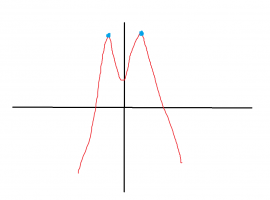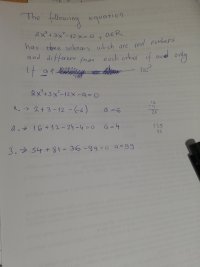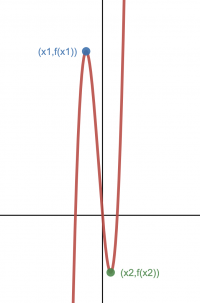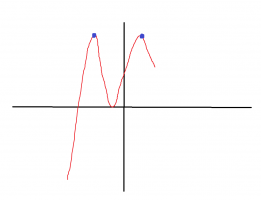Equation problem
- Thread starter Loki123
- Start date
BigBeachBanana
Senior Member
- Joined
- Nov 19, 2021
- Messages
- 2,277
Are you allowed to you calculus? You posted under algebra. Is there any restriction to what method is what I'm asking.I honestly don't know how to solve this. If it was a quadratic equation sure, but not this. View attachment 32343
No I know calculus. I just thought this was algebra. It wasn't stated.Are you allowed to you calculus? You posted under algebra. Is there any restriction to what method is what I'm asking.
BigBeachBanana
Senior Member
- Joined
- Nov 19, 2021
- Messages
- 2,277
Let's proceed with calculus then.No I know calculus. I just thought this was algebra. It wasn't stated.
For a cubic to have 3 distinct roots, it must satisfy these conditions:
1) Two real inflection points, x1,x2
2) f(x1)×f(x2)<0.
Find the inflection points.
What values of a will sastify this condition? f(x1)×f(x2)<0, then you'll have your answer.
c
can you explain this??2) f(x1)×f(x2)<0f(x_1)\times f(x_2)<0f(x1)×f(x2)<0.
Steven G
Elite Member
- Joined
- Dec 30, 2014
- Messages
- 14,591
Calculus works just fine and you should(!!) know how to use calculus to solve this problem.
However, using trial and error can be faster and has less room for error.
Are you allowed to graph the function? If yes, then graph it without a in it and see if you need to raise or lower the graph to get three roots. Adjust a accordingly.
However, using trial and error can be faster and has less room for error.
Are you allowed to graph the function? If yes, then graph it without a in it and see if you need to raise or lower the graph to get three roots. Adjust a accordingly.
Steven G
Elite Member
- Joined
- Dec 30, 2014
- Messages
- 14,591
f(x1)*f(x2)<0 is just another way of saying that f(x1) and f(x2) have different signs (one is negative and the other is positive)c
can you explain this??
works in what sense? when a = 0, x is either 0 or -3+sqrt(105)/2 or -3-sqrt(105)/2You need to find just one a such that the equation has three solutions.
I would first try to see if a=0 works
BigBeachBanana
Senior Member
- Joined
- Nov 19, 2021
- Messages
- 2,277
Calculus works just fine and you should(!!) know how to use calculus to solve this problem.
However, using trial and error can be faster and has less room for error.
Are you allowed to graph the function? If yes, then graph it without a in it and see if you need to raise or lower the graph to get three roots. Adjust a accordingly.
interesting, but why can't we have something like this (enjoy my paint drawing)View attachment 32344
Consider a generic cubic with 3 distinct roots. Notice that there are inflection points (condition 1). But for the function to cross the x-axis 3 times. One of them must be positive, and the other must be negative. In other words f(x1)×f(x2)<0

BigBeachBanana
Senior Member
- Joined
- Nov 19, 2021
- Messages
- 2,277
How many roots do you have in your picture?interesting, but why can't we have something like this (enjoy my paint drawing)View attachment 32345
Steven G
Elite Member
- Joined
- Dec 30, 2014
- Messages
- 14,591
I re-read the question and it say the function has three distinct roots if and only if a equals___?works in what sense? when a = 0, x is either 0 or -3+sqrt(105)/2 or -3-sqrt(105)/2
This is saying that there is exactly one such a that works. This is not true. I bet that a=1/2 would work.
BigBeachBanana
Senior Member
- Joined
- Nov 19, 2021
- Messages
- 2,277
Now you have 3 turning points. It's no longer a cubic.
Steve, the solution is an interval, not a single value.I re-read the question and it say the function has three distinct roots if and only if a equals___?
This is saying that there is exactly one such a that works. This is not true. I bet that a=1/2 would work.
Steven G
Elite Member
- Joined
- Dec 30, 2014
- Messages
- 14,591
What you are drawing are not cubic equations. They are either 4th degree or 6 degree or 8th degree.... equations! You are clearly give a 3rd degree equation!!!!!!
Steven G
Elite Member
- Joined
- Dec 30, 2014
- Messages
- 14,591
I was wondering about that.Now you have 3 turning points. It's no longer a cubic.
Steve, the solution is an interval, not a single value.
from my experience, the question is formed in that way regardless of how many solutions there is. The goal is usually to see who will recognize that there are more solutions.I re-read the question and it say the function has three distinct roots if and only if a equals___?
This is saying that there is exactly one such a that works. This is not true. I bet that a=1/2 would work.
i suck at graphing equations...What you are drawing are not cubic equations. They are either 4th degree or 6 degree or 8th degree.... equations! You are clearly give a 3rd degree equation!!!!!!
okay so what i seem to not be understanding is, how do turning points dictate how many solutions for x we have?Now you have 3 turning points. It's no longer a cubic.
Steve, the solution is an interval, not a single value.



